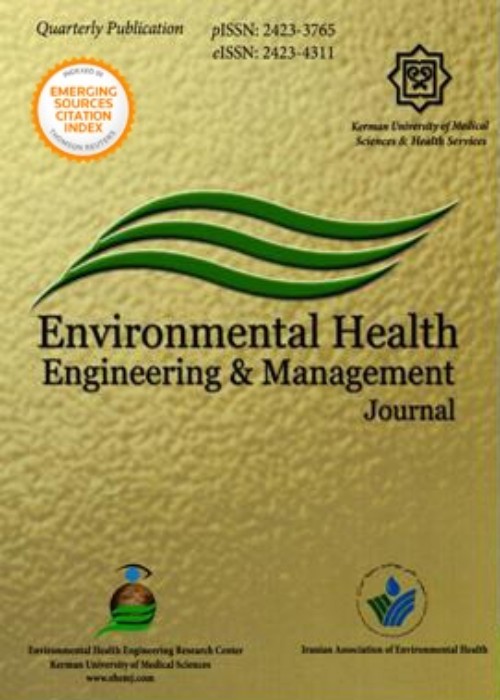Use of Aloe vera shell ash supported Ni0.5Zn0.5Fe2O4 magnetic nanoparticles for removal of Pb (II) from aqueous solutions
Author(s):
Abstract:
Background
Lead (Pb) is a heavy metal that is widely utilized in industries. It contaminates soil and groundwater. Its non-biodegradability, severe toxicity, carcinogenicity, ability to accumulate in nature and contaminate groundwater and surface water make this toxic heavy metal extremely dangerous to living beings and the environment. Therefore, technical and economic methods of removing Pb are of great importance. This study evaluated the efficiency of Ni0.5Zn0.5Fe2O4 magnetic nanoparticles supported by Aloe vera shell ash in removing Pb from aqueous environments.Methods
The adsorbent was characterized by several methods, including x-ray diffraction (XRD), scanning electron microscopy (SEM), and Fourier transform infrared spectroscopy (FT-IR). Then, the potential of Aloe vera shell ash-supported Ni0.5Zn0.5Fe2O4 magnetic nanoparticles to adsorb Pb (II) was investigated. To determine the amount of lead absorbed by this adsorbent, different pHs (2, 4, 5, and 6), adsorbent doses (0.01-0.40 g), Pb concentrations (5, 10, 20, 30, 40, 50, 60, 80, 100, 200, 300, and 600 mg/L), and exposure times (0, 5, 10, 15, 20, 30, 40, 50, and 60 minutes until reaching equilibrium) were tested using an atomic absorption spectrometer (Varian-AA240FS). Residual concentrations of Pb were read.Results
The results show that a time of 15 minutes, pH value of 9, and adsorbent dose of 0.2 g are the optimum conditions for Pb (II) removal by this adsorption process. Increasing the initial concentration of Pb (II) from 5 to 600 mg/L decreased removal efficiency from 98.8% to 73%. The experimental data fit well into the Freundlich isotherm model (R2 = 0.989).Conclusion
Ni0.5Zn0.5Fe2O4 magnetic nanoparticles supported by Aloe vera shell ash comprise a low-cost, simple, and environmentally benign procedure. The maximum monolayer adsorption capacity based on the Langmuir isotherm (R2 = 0.884) is 47.2 mg g-1. The prepared magnetic adsorbent can be well dispersed in aqueous solutions and easily separated from them with the aid of an external magnet after adsorption. The process for purifying water presented here is clean and safe. Therefore, this adsorbent is applicable to managing water pollution caused by Pb (II) ions.Keywords:
Language:
English
Published:
Environmental Health Engineering and Management Journal, Volume:3 Issue: 1, Winter 2016
Pages:
15 to 21
magiran.com/p1521904
دانلود و مطالعه متن این مقاله با یکی از روشهای زیر امکان پذیر است:
اشتراک شخصی
با عضویت و پرداخت آنلاین حق اشتراک یکساله به مبلغ 1,390,000ريال میتوانید 70 عنوان مطلب دانلود کنید!
اشتراک سازمانی
به کتابخانه دانشگاه یا محل کار خود پیشنهاد کنید تا اشتراک سازمانی این پایگاه را برای دسترسی نامحدود همه کاربران به متن مطالب تهیه نمایند!
توجه!
- حق عضویت دریافتی صرف حمایت از نشریات عضو و نگهداری، تکمیل و توسعه مگیران میشود.
- پرداخت حق اشتراک و دانلود مقالات اجازه بازنشر آن در سایر رسانههای چاپی و دیجیتال را به کاربر نمیدهد.
دسترسی سراسری کاربران دانشگاه پیام نور!
اعضای هیئت علمی و دانشجویان دانشگاه پیام نور در سراسر کشور، در صورت ثبت نام با ایمیل دانشگاهی، تا پایان فروردین ماه 1403 به مقالات سایت دسترسی خواهند داشت!
In order to view content subscription is required
Personal subscription
Subscribe magiran.com for 70 € euros via PayPal and download 70 articles during a year.
Organization subscription
Please contact us to subscribe your university or library for unlimited access!


